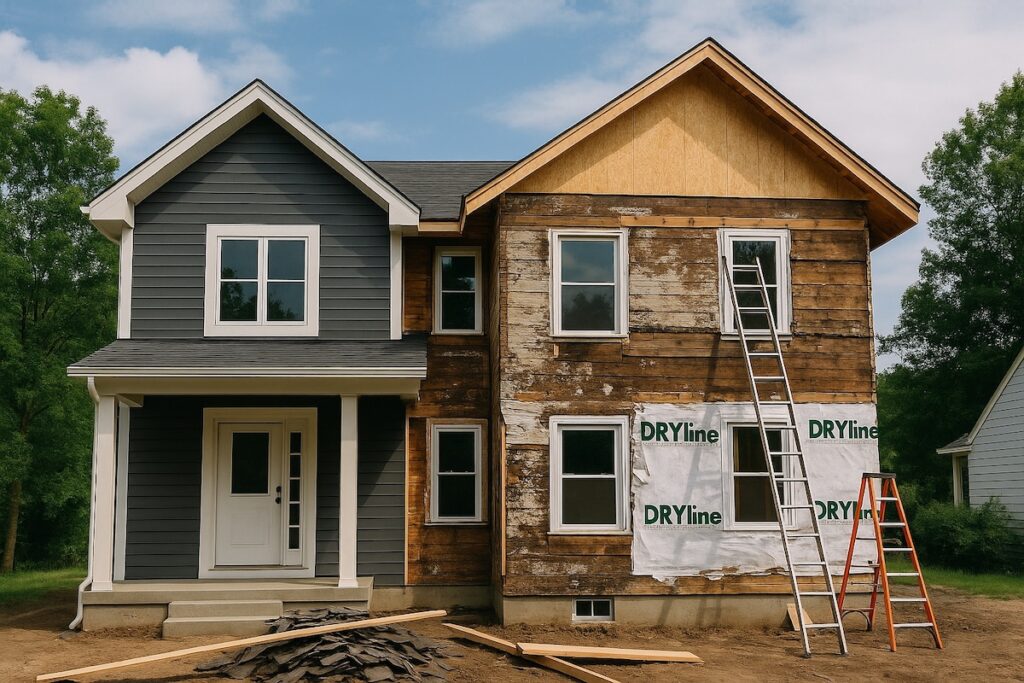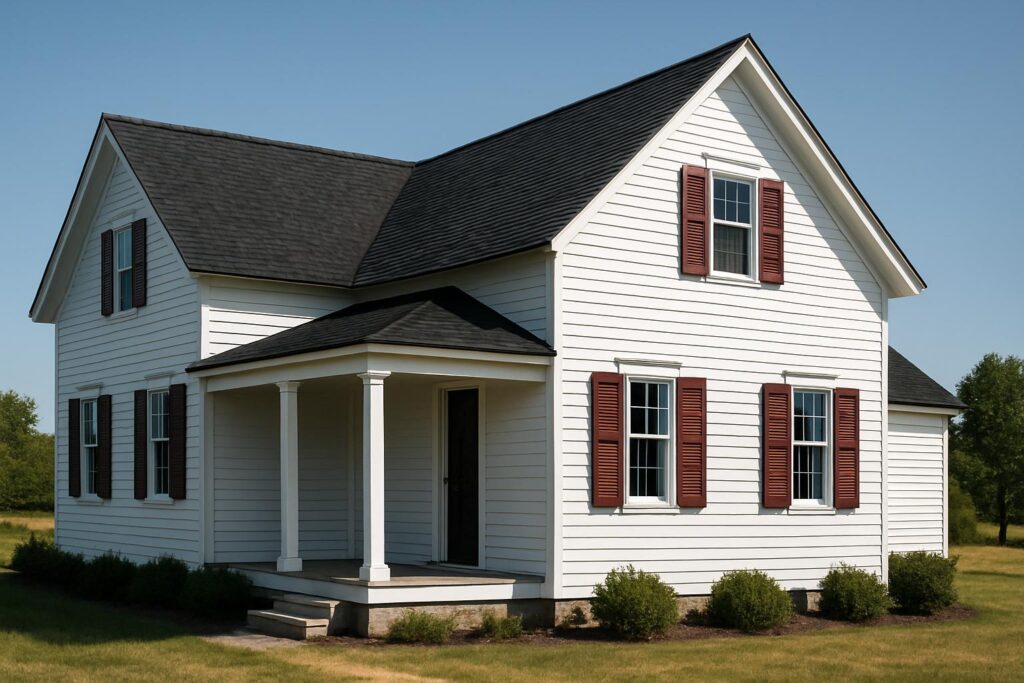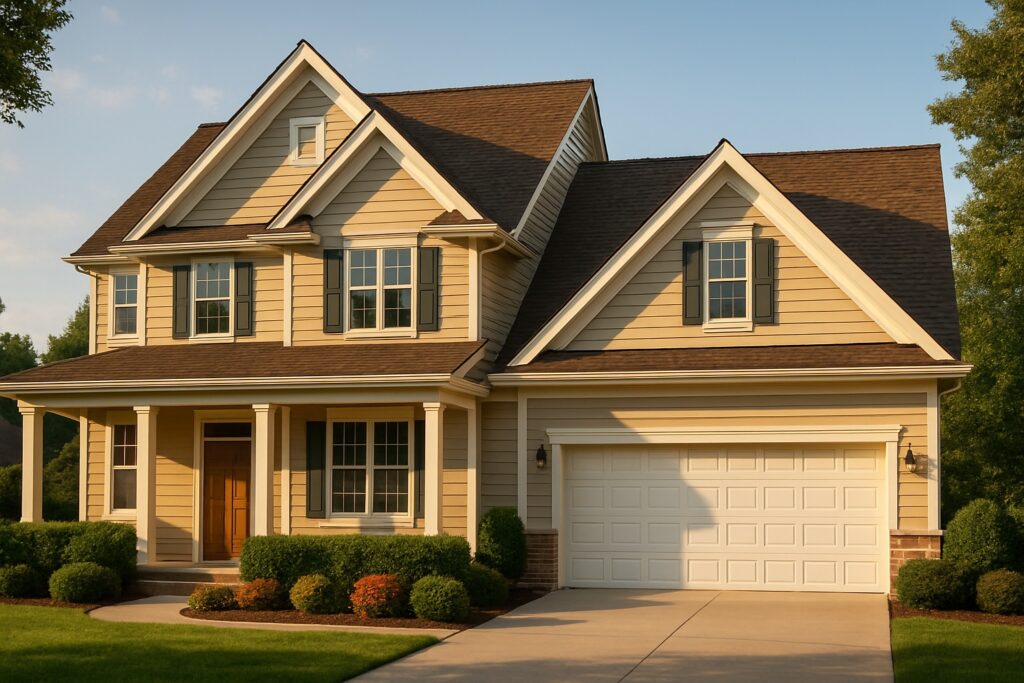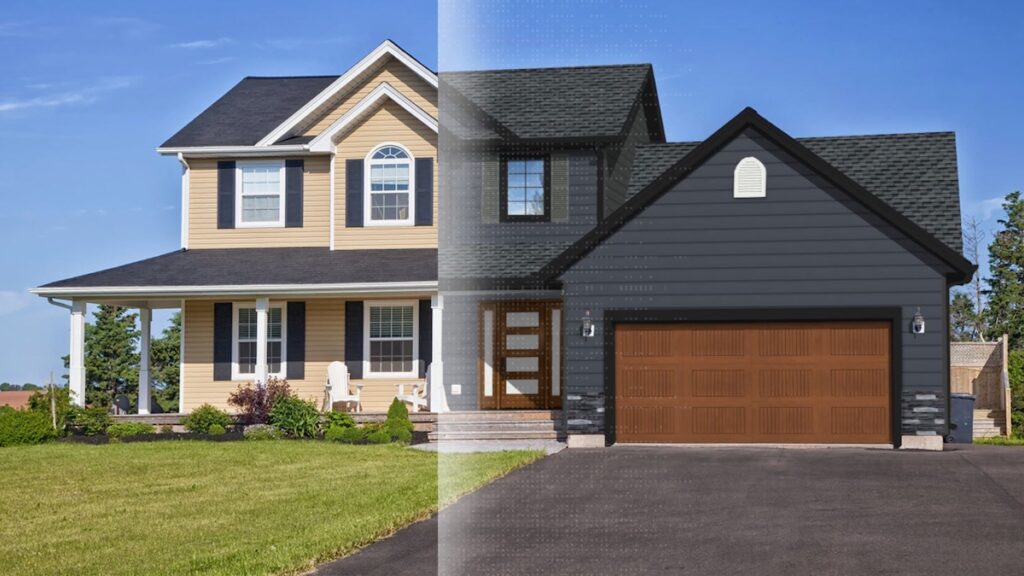Listen Now: Breaking Down The Cost To Renovate in 2025
TLDR
Planning a home renovation? Here’s a quick breakdown of the most important insights from this guide so you can budget smart, avoid surprises, and get the most out of your remodel:
Average home renovation costs range from $100–$400 per square foot depending on scope and region
Kitchen remodels are among the most expensive—especially with layout changes and premium finishes
Bathroom remodels can be high-impact and ROI-positive, with midrange updates starting around $12,000
Whole house renovations start around $150,000 and can reach $300,000+ for full gut remodels
Biggest cost factors include square footage, material choices, labor rates, and contractor experience
Don’t forget hidden costs like permits, HVAC upgrades, mold remediation, and fixture delays
Smart savings strategies include reusing layout, choosing midrange fixtures, and locking in decisions early
ROI winners: Kitchen, bathroom, and curb appeal upgrades deliver the highest long-term return
Want to see exactly what your remodel could look like—and what it might cost?
Use Renoworks’ Visualizer Tool to design your remodel, compare product options, and get a tailored renovation quote: Start Your Project Today →
Introduction
If you’re planning a home renovation, one of the biggest hurdles is getting a handle on the cost. Remodeling isn’t cheap—and between materials, fixtures, permits, and labor, it’s easy to lose track of where your money’s going. Whether you’re upgrading a bathroom, reimagining your kitchen, or considering a whole home renovation, this guide will walk you through everything you need to know to budget confidently, avoid surprises, and get the results you actually want.
We’ll also show you how Renoworks’ renovation quote tool can give you a realistic estimate based on your actual design and product choices—so you’re not left guessing.

Why Budgeting for a Remodel Is So Complicated (and So Important)
Renovating your home isn’t just about picking out pretty tiles and dreaming up new layouts. It’s also about managing your renovation costs—and that starts with understanding what really drives those numbers up or down.
For starters, here’s what impacts the average cost of a home renovation:
Square footage: A larger project area means more materials, more labor, and higher expenses.
Room type: Kitchens and bathrooms often cost the most per square foot because of the plumbing, fixtures, and specialized work involved.
Material quality: Going with custom cabinets, designer lighting, or stone countertops adds up fast.
Fixtures: Think sinks, bathtubs, faucets, and lighting—these small choices can make a big dent in your budget.
Contractor pricing: Your contractor’s experience level, timeline, and crew availability all affect final pricing.
Permits and inspections: These are often overlooked, but they’re necessary for structural changes, electrical updates, and plumbing.
The process of renovating requires planning, trust in your contractor, and a solid understanding of the renovation process from design to demolition and rebuild. If you’re new to remodeling, it can be intimidating—but the more informed you are, the better your decisions will be.
Renovation Costs by Room and Project Type
Let’s break things down by project type. This is where you’ll start to see how dramatically costs can vary—and why it’s smart to get tailored quotes based on your actual home.
Kitchen Remodel Costs
Kitchens are one of the most popular remodeling projects because of how much value they add to a home. But they’re also among the most expensive.
Minor kitchen remodels with refaced cabinets and basic fixtures: $23,000–$35,000
Midrange kitchen remodels with new cabinetry and appliances: $35,000–$65,000
High-end kitchen remodels with layout changes, high-end fixtures, and premium finishes: $75,000–$100,000+
Kitchen remodels typically include plumbing, electrical, flooring, tile, cabinetry, and lighting upgrades. Explore more kitchen design inspiration here. The average cost of kitchen remodels depends heavily on whether you’re renovating a small space or designing a full gourmet kitchen from scratch.
Bathroom Remodel Costs
The average cost to remodel a bathroom is about $8,000–$15,000 for a standard space. But if you’re adding custom tile work, a walk-in shower, or upscale fixtures, the price climbs fast.
Small bathroom: $7,000–$12,000
Standard full bath: $12,000–$25,000
Primary bath with custom features: $25,000–$40,000
Bathroom remodels are also shaped by layout, plumbing reroutes, fixture choices, and square footage. Always ask your contractor for a line-item quote so you can better understand how your average cost breaks down.
Exterior Renovation Costs
Exterior remodeling is one of the best ways to boost curb appeal—and it tends to deliver a strong return on investment. See top curb appeal upgrades and exterior ideas.
Siding installation (vinyl, fiber cement): $8,000–$20,000
Roof replacement: $10,000–$25,000
Window replacement: $500–$1,500 per window
Landscaping or hardscaping: $3,000–$15,000 depending on scope
An exterior home renovation can also include new garage doors, porch updates, and improvements to walkways and driveways.
Basement and Attic Renovations
Finishing these underused areas adds living space without extending your home’s footprint. But keep in mind, the cost per square foot can vary widely depending on complexity.
Finished basement: $30–$75 per square foot
Converted attic: $40–$85 per square foot
Whether you’re adding a bathroom, home office, or extra bedroom, these home remodel projects often require insulation, HVAC installation, and electrical work.
Whole Home Renovation Costs
If you’re planning to overhaul an entire home, you’re looking at serious investment—but also serious transformation. These projects often involve structural work, updated electrical and plumbing, layout changes, and major cosmetic upgrades.
Cosmetic remodel: $50,000–$90,000
Full gut renovation: $150,000–$300,000
Complete teardown and rebuild: $250–$400+ per square foot
Whole home renovations are often completed in phases and require heavy coordination between contractors, designers, and inspectors. These large-scale remodels typically include everything from kitchens and bathrooms to basements, roofs, flooring, and windows.
What Impacts the Cost of Renovating?
Your renovation price isn’t just tied to the size of the project. Many factors shape the average cost of a remodel, including:
Type of materials used
Labor rates in your area
Age and condition of your house
Complexity of the layout or design changes
Permit costs and inspections
Availability of skilled contractors
Understanding how these factors affect your final quote is key to staying on budget.
How to Choose the Right Contractor for Your Home Remodel
Finding a trustworthy contractor is one of the most important decisions you’ll make during a home remodel. The right professional can bring your vision to life, stay on budget, and finish on time—while the wrong one can cause delays, unexpected costs, and stress.
Start by asking friends or neighbors for referrals, and make sure to check online reviews and licensing information. Interview at least three contractors and ask for detailed estimates that break down labor, materials, and contingencies. Don’t be afraid to ask questions about timelines, insurance, and whether they’ll be on-site or subcontracting work.
Remember: a good contractor doesn’t just quote you a price—they educate you about what’s realistic based on your home, square footage, and renovation goals.
Planning a Whole House Renovation: What to Expect
Whole house remodels are transformative—but they’re also a big commitment. If you’re updating every room in your house, or gutting and rebuilding large areas, be prepared for a longer timeline, bigger budget, and more decisions.
Expect to start with a home inspection and layout consultation. Then you’ll work with your contractor to phase the work by room or system (kitchen, electrical, HVAC, etc.). It’s important to get a quote based on square footage and project scope—and to build in time for approvals, inspections, and ordering materials.
While some families move out during major renovations, others choose to live through them. In either case, planning ahead and understanding the full scope makes all the difference.
How Remodeling Projects Affect Homeowners Emotionally and Financially
A remodel isn’t just a financial investment—it’s an emotional one. Living through construction can be noisy, dusty, and stressful. Decisions stack up fast, especially with big-ticket items like flooring, cabinetry, and fixtures. And budget creep can add anxiety if you’re not prepared.
To stay sane, build in buffer time and budget. Make decisions early and stick to them. Lean on your contractor for guidance, and remember why you started the remodel in the first place: to create a home that better supports your life.
Home renovation is one of the most personal projects you’ll ever take on. Give yourself space to be human during it.
Top Mistakes to Avoid When Renovating Your Home
Even experienced homeowners fall into these common traps:
Underestimating average costs or square footage needs
Not having a clear scope or budget from the start
Hiring a contractor without checking credentials or references
Skipping permits to save time or money
Making late-stage changes that delay the timeline and increase costs
Avoid these pitfalls by doing your homework and leaning on expert advice throughout the remodel.
Is Now the Right Time to Remodel? How Market Trends Influence Renovation Costs
Timing can impact both your budget and your peace of mind. During times of high demand—like spring and summer—contractors may charge more or have longer waitlists. Material prices can fluctuate due to supply chain issues, and interest rates may affect whether you use financing.
That said, there’s no perfect time to start a home renovation. If you have a clear vision, a good contractor, and a strong quote, the right time might be now.
Watch trends but plan based on your life—not just the market.
Regional Differences in Remodeling Costs
Where you live plays a major role in how much your renovation will cost. A kitchen remodel in a major metro like San Francisco or Toronto will cost significantly more than one in a smaller town. Local labor rates, permit fees, materials availability, and even weather can influence project pricing.
Urban areas: Expect higher labor rates and permit costs
Rural or suburban areas: Lower contractor fees but limited material availability
Climate-specific upgrades: Some regions may require more robust insulation, window performance, or HVAC systems, which adds to cost
It’s always smart to get estimates from local professionals who understand regional building codes and seasonal construction timelines.
Long-Term ROI of Home Renovations
While upfront cost matters, it’s important to think long-term. Remodeling can boost your home’s resale value and make it more comfortable and efficient.
Projects with the strongest return on investment include: Compare ROI across different siding materials.
Kitchen remodels (60–80% ROI)
Bathroom renovations (50–70% ROI)
Curb appeal upgrades like siding and roofing (70–90% ROI)
Energy-efficient upgrades like new windows, doors, insulation, and HVAC systems not only increase home value but also reduce monthly costs—adding to their overall return over time.
If you’re planning to stay in your home long-term, prioritize improvements that enhance daily life: layout changes, additional bathrooms, smart home tech, and storage upgrades.
Cost Breakdown by Line Item
Want to understand where your money is going? Here’s a rough breakdown of how your total renovation budget may be allocated:
Labor: 30–50%
Materials: 25–40%
Fixtures and finishes: 10–20%
Permit and inspection fees: 5–10%
Contingency fund: 10–20%
Reviewing line items in your contractor’s estimate helps ensure transparency and lets you spot opportunities to save. Don’t be afraid to ask for alternate material suggestions or more affordable fixture options.
How to Renovate Smarter (Not Just Cheaper)
Here’s how homeowners make the most of their budget:
Focus on rooms with strong ROI—like kitchens, bathrooms, and curb appeal upgrades
Stick with midrange materials for good value and durability
Avoid moving plumbing and load-bearing walls if possible
Compare contractor bids side-by-side
Lock in material selections before you build to avoid costly changes
Working with a contractor you trust is crucial. Ask for referrals, check reviews, and confirm licensing. Be sure to discuss every detail of the remodel, including square footage changes, fixture installations, and the scope of each renovation phase.
Sample Renovation Budgets (And What They Actually Cover)
Here’s how real-life renovation budgets shake out:
$10,000 or less: Paint, light fixtures, trim work, and basic flooring upgrades
$10,000–$25,000: Bathroom remodel or partial kitchen upgrade
$25,000–$50,000: Midrange kitchen or bathroom remodel, new siding, or window updates
$50,000–$100,000: Structural changes, major appliance upgrades, premium materials
$100,000+: Whole home renovation, layout redesign, luxury finishes
Don’t Forget These Hidden Costs
Even a simple home remodel can go over budget when these surprise costs pop up:
Mold or water damage hidden behind walls
Upgrades to old electrical or plumbing to meet code
Flooring level changes from room to room
Custom fixture or cabinetry delays
Material backorders
It’s a good rule of thumb to set aside 10–20% of your total renovation cost as a contingency.
Why a Tailored Renovation Quote Matters
Most homeowners rely on general online estimates, which rarely reflect the actual costs in their market or for their specific home. That’s where a custom renovation quote makes a difference.
Renoworks gives you an edge by combining real material choices with regional contractor pricing and design intent.
You’ll get:
A quote based on real square footage and design inputs
Actual fixtures and materials pulled from top-tier brands
A list of qualified contractors who can execute your vision
The more detailed the quote, the fewer surprises—and the more confident you’ll be when hiring pros.
Final Thoughts: Make Every Dollar Count
Home renovation is never one-size-fits-all. From kitchen remodels to basement overhauls, every project comes with its own budget, timeline, and challenges. The best remodels begin with solid research, realistic expectations, and detailed quotes.
Take the time to learn about your home renovation options. Find design inspiration across every room and style. Know your square footage. Understand the average costs for each room. And above all, work with a contractor who respects your goals and your budget.
Once you have a clear plan, you’ll be able to move forward with confidence—and transform your house into the home you’ve always wanted.
Frequently Asked Questions About Home Renovations
1. What is the average cost of a home renovation per square foot? The average cost of a home renovation typically ranges from $100 to $400 per square foot, depending on the complexity of the remodel, your location, and the contractor you hire. For full home remodels or whole house renovations that involve layout changes, new flooring, HVAC, and premium fixtures, expect to be at the higher end of that range.
2. How much does a kitchen remodel cost in 2025? A kitchen remodel varies widely based on square footage, material quality, and design changes. A minor kitchen remodel may cost around $25,000–$35,000, while a high-end kitchen renovation with structural changes, custom cabinets, and luxury fixtures can exceed $100,000.
3. What’s the ROI of a bathroom remodel versus a kitchen remodel? Both kitchen and bathroom remodels deliver strong ROI. A midrange bathroom remodel offers a 50–70% return on investment, while a kitchen remodel can yield 60–80%, especially if energy-efficient fixtures and modern design are included.
4. How do I estimate the cost of a whole house remodel? Whole house remodels involve extensive work—from HVAC and electrical to drywall, painting, and flooring. The best way to estimate costs is to use a tailored home renovation quote that factors in square footage, fixtures, and regional labor rates. Expect costs between $150,000–$300,000 depending on your goals.
5. Can I renovate my home in stages to save money? Yes, phasing your renovation project—starting with a bathroom or kitchen remodel and moving room by room—can help control renovation costs and reduce disruption. Just ensure your contractor builds a long-term plan that accommodates future upgrades.
6. How does drywall replacement factor into my renovation cost? Drywall work is often an underestimated cost in remodeling projects. Whether you’re opening up walls for plumbing, electrical, or insulation upgrades, expect to pay $1.50–$3.50 per square foot for drywall removal and replacement, especially in older homes.
7. What are the typical permit requirements for a home remodel? Permit requirements vary by location, but any remodel involving structural changes, HVAC upgrades, or electrical rewiring will likely need municipal approval. Factor permit and inspection fees into your renovation budget early.
8. How do I choose fixtures that balance quality and cost? Look for midrange fixtures that offer style, durability, and efficiency. Smart faucets, energy-saving lighting, and builder-grade options from trusted brands can help you stay within budget while still elevating the look and function of your remodel.
9. Should I upgrade my HVAC system during a home renovation? If your HVAC system is over 15 years old or isn’t performing efficiently, it’s smart to include it in your renovation. New systems can reduce energy bills and improve indoor comfort—especially if you’re adding square footage during a whole house renovation.
10. Is painting included in most renovation estimates? Interior and exterior painting are often considered separate line items in contractor quotes. Depending on surface prep and paint quality, costs can range from $2 to $6 per square foot. Confirm whether painting is bundled with your other home remodel services.
11. How can I avoid cost overruns during my renovation? Finalize your renovation plans, select fixtures early, and leave a 10–20% contingency in your budget. Using a detailed renovation quote, hiring a reliable contractor, and avoiding mid-project changes are key to staying on track.
12. Are flooring upgrades worth the investment in a whole home renovation? Absolutely. Flooring impacts every room in your house. Upgrading to durable materials like luxury vinyl plank, engineered hardwood, or tile improves aesthetics, resale value, and daily function—especially in high-traffic areas like kitchens and bathrooms.
HOME VISUALIZER TOOL
Still Imagining? Start Designing.
Visualize your home — for free. Instantly explore siding styles, colors, and renovations with just one photo. No forms. No pressure. Just results.







